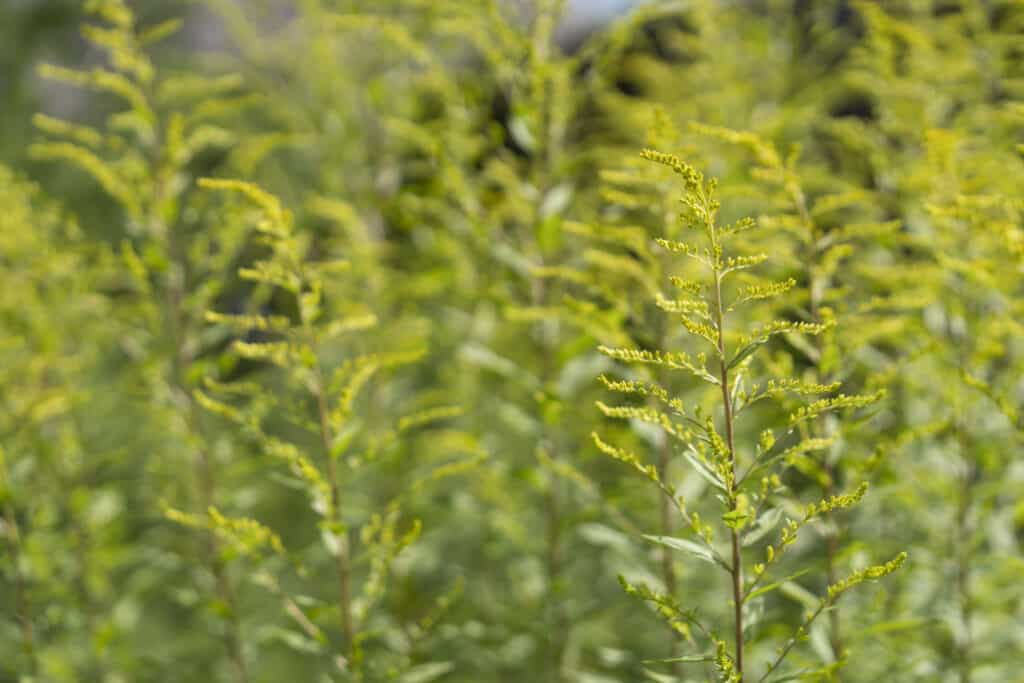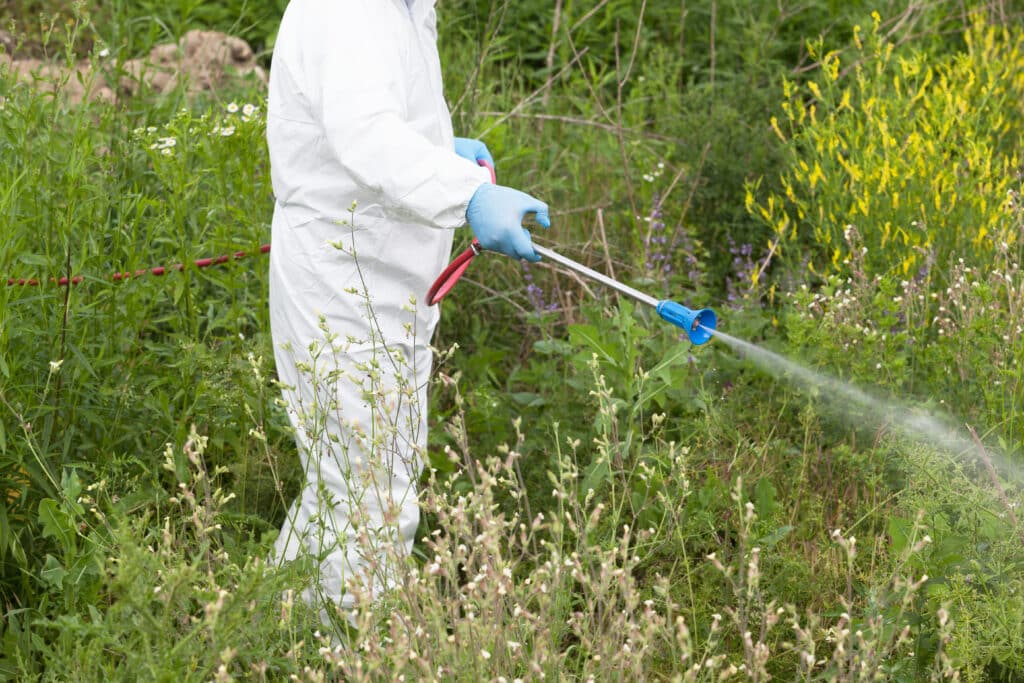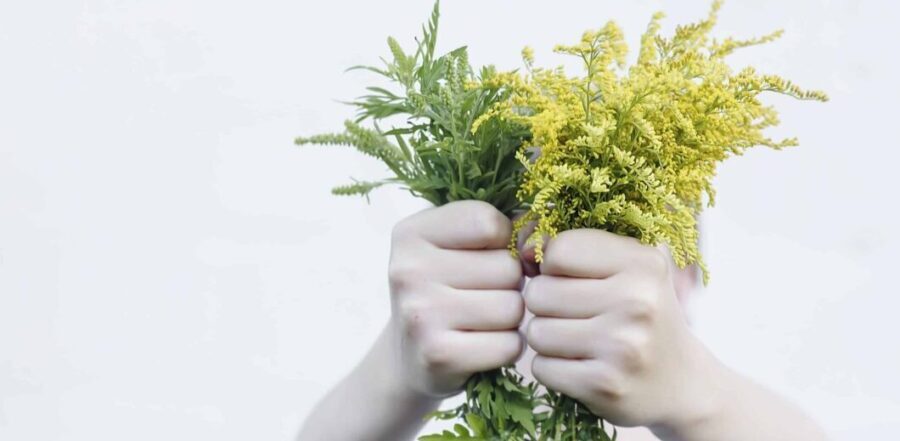Identifying True Allergens: Goldenrod Vs Ragweed
Many people get allergies and often think flowers like goldenrod are to blame. But actually, ragweed is the real troublemaker. This article talks about two plants – goldenrod and ragweed.
They look a bit alike and belong to the same family of plants, but they are very different. Goldenrod has pretty yellow flowers that bees love, while ragweed’s green blooms don’t stand out as much.
Around 10 to 20 percent of Americans feel sick from ragweed pollen, which flies through the air in many places from July to October. However, goldenrod pollen is heavy and falls to the ground instead of floating in the breeze, making it unlikely to cause sniffles or sneezes.
It’s important for us all when we try to stop our allergy symptoms, we don’t mix up these two plants! We also want butterflies and bees around because they help grow food by spreading pollen between flowers.
If you’re feeling stuffy or your eyes water during late summer or fall, you might be looking at ragweed as your problem – not beautiful goldenrod.
This introduction leads into an article full of facts about how each plant grows, where you can find them, what their pollen does, and how you can control allergies without hurting helpful insects like bees and butterflies.
You’ll learn more interesting things ahead!
Key Takeaways
-
- Goldenrod is often blamed for allergies, but its heavy pollen needs bees to move it and does not fly through the air easily. Ragweed’s light pollen spreads with the wind and causes allergy symptoms.
-
- Both plants bloom at similar times in fields and roadsides, but ragweed is more likely to grow in disturbed soils and urban areas.
-
- To manage these plants, mow lawns regularly to keep them short, use masks when outside, remove weeds by hand or with herbicides, close windows during peak pollen season, and choose different flowers for a garden that helps bees without causing allergies.
What is Goldenrod, and What is Ragweed?
Goldenrod and ragweed are plants in the asteraceae family but have distinct differences. Goldenrod is known for its bright yellow flowers and attractive appearance, while ragweed has small, non-descript greenish flowers.
Understanding their characteristics can help identify them accurately and manage their impact on allergies and ecosystems.
Description and characteristics
Goldenrod and ragweed may look alike from far away, but they are very different up close. Goldenrod flowers pop bright yellow, and their heavy pollen grains need bees to move them around.
These plants stand out in gardens because of their showy yellow blooms that gather a crowd—bees and butterflies love them.
Ragweed is not pretty like goldenrod. It has greenish flowers that don’t catch your eye. Instead of needing bugs to carry pollen, the wind blows ragweed’s lightweight pollen far and wide.
This is bad news for people with allergies because just one plant can fill the air with many pollen grains. That’s why many sneeze and sniffle when ragweed blooms!
Similarities and differences
When exploring the natural elements that could be impacting your health, it’s essential to distinguish between goldenrod and ragweed. Despite their parallel penchant for blooming and shared family ties, these two plants couldn’t be more different regarding their role in seasonal allergies.
| Characteristics | Goldenrod (Solidago spp.) | Ragweed (Ambrosia spp.) |
| Plant Type | Perennial | Annual |
| Stem | Single-stemmed or branched | Highly branched |
| Flower Color | Bright yellow | Greenish, less noticeable |
| Bloom Time | Late summer to fall | Late summer to fall |
| Pollen Production | Low, sticky pollen | High, wind-dispersed pollen |
| Allergenicity | Unlikely to cause allergies | Common allergen |
| Habitat | Meadows, roadsides | Disturbed soils, urban areas |
A closer examination of these points shows that while both plants may be active during the same season, their impact on human health diverges sharply. Ragweed pollen, not its golden-hued cousin, is the real perpetrator behind those sniffling and sneezing fits. Understanding these nuances can empower you to manage your environment for optimum health better.
Identifying Goldenrod and Ragweed
When identifying goldenrod and ragweed, paying attention to their appearance, growth patterns, common locations, blooming season, and associated symptoms is important.
Goldenrod is known for its vibrant yellow flowers and upright growth habit, while ragweed typically has green flowers and a more sprawling growth pattern. Additionally, goldenrod tends to bloom in late summer or fall and is often wrongly blamed for causing hay fever symptoms caused by ragweed allergies.
Appearance and growth patterns
Goldenrod and ragweed both grow outdoors, but they look different. Knowing what each plant looks like can help you stay away from allergies.
-
- Goldenrod stands tall, up to 4 feet, with bright yellow flower clusters.
-
- Ragweed grows about the same height but has green flowers that are less showy.
-
- Leaves on goldenrod plants are smooth and pointy at the ends.
-
- The leaves of common ragweed have a rough texture and are often lobed or divided.
-
- A single-stemmed goldenrod shows off its flowers on top like a flag waving in the wind.
-
- Ragweed plants spread their branches out with flowers hanging below the leaves.
-
- Goldenrod blooms in late summer when butterflies love to visit for nectar.
-
- Ragweed blooms around the same time, but their pollen can travel far and cause hay fever.
-
- You’ll see goldenrods in open fields and along roadsides where they get lots of sun.
-
- Ragweed often appears in disturbed soils, like gardens or urban settings.
Common locations and habitats

Goldenrod and ragweed can be found in various locations and habitats across North America. They thrive in specific environments, adapting to different conditions. Here are the common locations and habitats where you might find these plants:
- Roadside Ditches: Both goldenrods and ragweed can often grow along roadsides, taking advantage of the open space and sunlight.
- Open Fields: These plants favor open fields, with room to spread and grow without much competition from other vegetation.
- Dry Areas: Goldenrods flourish in drier, well-drained soils, while ragweed is adapted to dry and disturbed areas like construction sites or abandoned lots.
- Woodland Edges: Some species of goldenrod thrive at the edges of wooded areas, particularly where there’s plenty of sunlight filtering through the trees.
- Coastal Regions: Certain types of goldenrods are well-suited to coastal environments, tolerating salt spray and sandy soils.
- Urban Environments: Ragweed is adaptable and can be found even in urban settings, growing in vacant lots, parks, and other neglected areas.
- Disturbed Ground: Both goldenrods and ragweed are pioneer species that quickly colonize disturbed ground, such as cleared land or recent burns.
Blooming season and symptoms
Goldenrod and ragweed bloom between July and October, causing seasonal allergy symptoms such as sneezing, runny nose, and itchy eyes. During this time:
-
- The blooming season of goldenrod and ragweed overlaps.
-
- Both plants release pollen, contributing to allergy symptoms.
-
- Symptoms of goldenrod allergies may include sneezing and runny nose.
-
- Ragweed allergies may cause more severe symptoms like itchy eyes and congestion.
-
- Identifying the source of allergy symptoms can be challenging due to the overlapping blooming season of these plants.
The Impact of Goldenrod and Ragweed
The Impact of Goldenrod and Ragweed is significant for human health and the ecosystem. Ragweed allergies can cause a range of symptoms, while goldenrod is an important plant for pollinators and supports the biodiversity of local ecosystems.
Understanding their impact is vital for gardeners, allergy sufferers, and environmental enthusiasts alike.
Allergies and health effects
Goldenrod and ragweed can have different effects on your health. Ragweed is a common allergen, affecting millions of people and causing allergic reactions such as sneezing, runny nose, and itchy eyes.
Approximately 10 to 20 percent of Americans suffer from ragweed allergies. The tiny pollen grains released by ragweed plants during its blooming season can travel through the air for miles, potentially triggering allergy symptoms in hay fever sufferers.
On the other hand, goldenrod often gets wrongly blamed for causing allergies because its pollen is too heavy to be carried by the wind. It provides pollen for bees and other pollinators but doesn’t contribute significantly to airborne allergies compared to ragweed.
Benefits for pollinators and the ecosystem
Goldenrod is a valuable resource for pollinators like bees and butterflies. It provides nectar and pollen, supporting their survival. This plant’s bright yellow blooms attract these beneficial insects, aiding in pollinating other plants and promoting a healthy ecosystem.
Ragweed, on the other hand, does not offer similar benefits to pollinators. Its pollen can cause human allergies but doesn’t contribute positively to the ecosystem. Understanding the distinction between goldenrod and ragweed is essential for helping to support pollinators’ well-being and maintaining a balanced environment rich in biodiversity.
How to Manage and Control Goldenrod and Ragweed
When it comes to managing and controlling goldenrod and ragweed, prevention is key. This includes regularly mowing lawns, removing weeds from the garden, and using herbicides when necessary.
Additionally, incorporating pollinator-friendly plants in your garden can help minimize the impact of these allergens while still supporting local ecosystems.
Prevention and elimination methods

-
- Regularly mow your lawn to prevent ragweed and goldenrod from spreading their pollen.
-
- Use a mask while doing outdoor activities to minimize inhaling allergens.
-
- Identify and remove goldenrod and ragweed from your property to reduce exposure.
-
- Consider using herbicides specifically designed for ragweed and goldenrod control.
-
- Plant native, pollinator-friendly species to attract beneficial insects that can help keep ragweed and goldenrod in check.
-
- Keep windows closed during peak pollen seasons to limit indoor exposure.
-
- Consult with a healthcare professional for appropriate allergy medications or immunotherapy options.
Alternative options for pollinator-friendly plants
- Incorporate native flowering plants in your garden, such as bee balm, butterfly weed, and coneflowers. These plants provide nectar for pollinators and support the local ecosystem.
- Choose various flowers that bloom at different times of the year to ensure a consistent food source for pollinators throughout the seasons.
- Include flowering herbs like lavender, thyme, and mint to attract bees and butterflies while adding diversity to your garden.
- Plant milkweed to provide essential food for monarch butterflies during their migration.
- Consider adding fruit-bearing trees and shrubs like cherry, apple, or blueberry bushes to attract pollinators with their blossoms and provide food sources later in the season.
- Create a diverse habitat with a mix of plant heights and structures to accommodate a wide range of pollinators, including ground-nesting bees and butterflies seeking shelter.
- Avoid using pesticides and herbicides in your garden as they can harm beneficial insects such as bees and butterflies.
FAQs
1. What is the main difference between goldenrod and ragweed?
The main difference is that goldenrod has big, heavy pollen that bees carry, while ragweed’s smaller pollen can blow for miles in the wind, which often causes fall allergies.
2. How can I tell if a plant is a goldenrod or ragweed?
You can tell by looking at the plant’s flowers and leaves: Goldenrod has bright yellow flowers pollinated by bees and large, heavy pollen grains, whereas ragweed has tiny greenish-yellow flowers that produce massive amounts of small pollen grains blown by winds.
3. Why do people often blame goldenrod for allergies instead of ragweed?
People may mistake goldenrod for causing allergies because it blooms simultaneously as ragweed; however, it’s usually not to blame because its pollen does not fly through the air like ragweed’s does.
4. Can one single ragweed plant affect my allergies?
Yes! A single ragweed plant can produce over a billion tiny pollen grains that can cause allergic reactions during late summer into fall allergy season.

